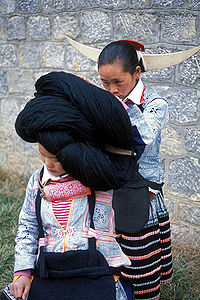Qo Xiong people

Headdress of the Long-horn Miao—one of the small branches of Miao living in the 12 villages near Zhijin County (织金县), Guizhou Province of China
|
|
| Total population | |
|---|---|
| (11–12 million) | |
| Regions with significant populations | |
|
China: 9,426,007(2010) Vietnam: 1,068,189 (2009) Laos: 460,000 (2005) United States: 247,595 (2010) Thailand: 151,080 (2002) France: 13,000 (including 3,000 in French Guiana) |
|
| Languages | |
| Hmongic languages, language(s) of residential country(s) | |
| Religion | |
| Miao folk religion. Minorities: Taoism, Christianity, Buddhism |
| Miao people | |||||||||||||||||||||||||
| Chinese | |||||||||||||||||||||||||
|---|---|---|---|---|---|---|---|---|---|---|---|---|---|---|---|---|---|---|---|---|---|---|---|---|---|
|
|||||||||||||||||||||||||
| Transcriptions | |
|---|---|
| Standard Mandarin | |
| Hanyu Pinyin | Miáozú |
| Wu | |
| Romanization | Miau-zoh |
| Hakka | |
| Romanization | Mèu-tshu̍k |
| Southern Min | |
| Hokkien POJ | Biâu-cho̍k |
| Teochew Peng'im | Miêu-tsôk |
| Eastern Min | |
| Fuzhou BUC | Mièu-cŭk |
The Miao is an ethnic group recognized by the government of China as one of the 55 official minority groups. Miao is a Chinese term and does not reflect the self-designations of the component groups of people, which include (with some variant spellings) Hmong, Hmub, Xong (Qo-Xiong), and A-Hmao.
The Chinese government has grouped these people and other non-Miao peoples together as one group, whose members may not necessarily be either linguistically or culturally related, though the majority are members of Miao-Yao language family, which includes the Hmong, Hmub, Xong, and A-Hmao and the majority do share cultural similarities. Because of the previous given reasons, many Miao peoples cannot communicate with each other in their mother tongues, and have different histories and cultures. A few groups designated as Miao by the PRC do not even agree that they belong to the ethnic group, though most Miao groups, such as the Hmong and Hmub, do agree with the collective grouping as a single ethnic group – Miao.
The Miao live primarily in southern China's mountains, in the provinces of Guizhou, Hunan, Yunnan, Sichuan, Guangxi, Hainan, Guangdong, and Hubei. Some members of the Miao sub-groups, most notably the Hmong people, have migrated out of China into Southeast Asia (northern Vietnam, Laos, Burma (Myanmar) and Thailand). Following the communist takeover of Laos in 1975, a large group of Hmong refugees resettled in several Western nations, mainly in the United States, France, and Australia. There has been a recent tendency by Hmong Americans to group all Miao peoples together under the term Hmong because of their disdain for the Chinese term Miao. This however fails to recognize that the Hmong are only a subgroup within the broader linguistic and cultural family of Miao people and the vast majority of Miao people do not classify themselves as Hmong and have their own names for themselves.
...
Wikipedia
